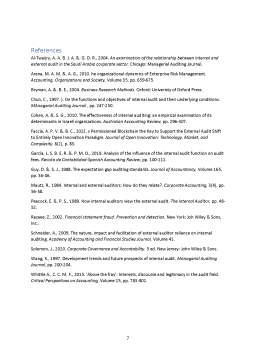Extras din referat
1.Introduction
In the financial sector and capital markets, external audit has been a priority area for a long time. There is a long history behind it arising mainly from the separation between ownership and management-stewardship theory. The purpose of an external audit is to provide an opinion on whether or not the financial statements give a true and fair picture of the financial situation of the entity. According to (Wang, 1997), external audit enhances enterprise performance and controls shareholder capital occupation, which empirically tests the impact of high-quality audit on corporate governance. The nature of the work associated with detecting material misstatements imposes inherent limitations due to its nature: probability of collusion, judgements, persuasive evidence, the scope of audit procedures used in detecting material misstatements. Therefore, only reasonable assurance can be provided. It is considered that the auditors' responsibilities are different from what the public and other users of financial statements perceive as their responsibilities, and what the auditors’ responsibilities entail when it comes to auditing. This is known as the auditing expectations gap. There has been considerable attention paid in the accounting literature to the topic of expectation gap (Commission on Auditors' Responsibilities, 1978; (Guy, 1988)
Due to a series of catastrophic corporate collapses, independent audits became increasingly important in the business ecosystem as a result.
1.2 Motivation behind topic
In choosing this topic, I was motivated by the increase in corporate failures and their association with endogenous factors caused by substandard management and weak corporate governance. This research is intended to find why there is a continuation of misinforming financial reports where corporate reporting environment is characterized by strict accounting and auditing rules and corporate governance requirements (Razaee, 2002). In the study, three of the largest collapses in the United Kingdom are examined: Carillion, Patisserie Valerie, British Home Stores. This study aims to identify the factors that contribute to the failure of these companies.
1.3 Objectives of the research
The objective of this study is to identify the external audit treatment each company received. In order to determine if audit reports differed from reality, an analysis of existing specialist literature will be undertaken together with their annual reports. It is within this context that the following research objectives will be examined:
Initially, the importance of identifying deficiencies in the internal control function, as well as the basis for evaluating materiality, will be discussed. In the research literature, failures of the internal control system are strongly correlated with corporate failures
Second, it is crucial to examine what specialist literature has found about the confidence of external auditors and their approach to internal audit mechanisms. Detection and recognition of fraud is often the evidence that this mechanism is not working as intended. The effectiveness of internal controls depends on the quality of the risk analysis supporting them. In order to manage internal risks effectively, those areas that require intensive risk taking must be identified (Solomon, 2020)
Furthermore, the independence of the auditors is of major significance. Assessing potential conflict of interests between the audit companies and the businesses in question in terms of trust, lawfulness, and fairness of financial data disclosed (Faccia, 2022). It would also be prudent to look at whether there were any cosy relationships between the engagement teams and clients that developed due to the lengthy tenure of the engagement teams.
Bibliografie
Al‐Twaijry, A. A. B. J. A. &. G. D. R., 2004. An examination of the relationship between internal and external audit in the Saudi Arabia corporate sector. Chicago: Managerial Auditing Journal.
Arena, M. A. M. &. A. G., 2010. he organizational dynamics of Enterprise Risk Management. Accounting, Organizations and Society, Volume 35, pp. 659-675.
Bryman, A. &. B. E., 2004. Business Research Methods. Oxford: Univeristy of Oxford Press.
Chun, C., 1997. ). On the functions and objectives of internal audit and their underlying conditions. MAnagerial Auditing Journal , pp. 247-250.
Cohen, A. &. S. G., 2010. The effectiveness of internal auditing: an empirical examination of its determinants in Israeli organizations. Australian Accounting Review, pp. 296-307.
Faccia, A. P. V. &. B. C., 2022. s Permissioned Blockchain the Key to Support the External Audit Shift to Entirely Open Innovation Paradigm. Journal of Open Innovation: Technology, Market, and Complexity, 8(2), p. 85.
García, L. S. B. E. R. &. P. M. O., 2019. Analysis of the influence of the internal audit function on audit fees. Revista de Contabilidad-Spanish Accounting Review, pp. 100-111.
Guy, D. &. S. J., 1988. The expectation gap auditing standards. Journal of Accountancy, Volume 165, pp. 36-46.
Mautz, R., 1984. Internal and external auditors: How do they relate?. Corporate Accounting, 3(4), pp. 56-58.
Peacock, E. &. P. S., 1989. How internal auditors view the external audit. The Internal Auditor, pp. 48-52.
Razaee, Z., 2002. Financial statement fraud. Prevention and detection. New York: Joh Wiley & Sons, Inc..
Schneider, A., 2009. The nature, impact and facilitation of external auditor reliance on internal auditing. Academy of Accounting and Financial Studies Journal, Volume 41.
Solomon, J., 2020. Corporate Covernance and Accontability. 5 ed. New Jersey: John Wiley & Sons.
Wang, X., 1997. Development trends and future prospects of internal audit. Managerial Auditing Journal, pp. 200-204.
Whittle A., C. C. M. F., 2015. ‘Above the fray’: Interests, discourse and legitimacy in the audit field. Critical Perspectives on Accounting, Volume 25, pp. 783-802.
Preview document
Conținut arhivă zip
- Corporate collapse in UK and their audit treatment.docx










